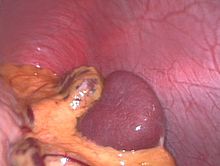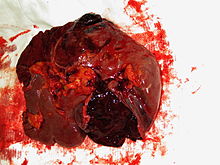spleen

The spleen ( latin lien , ancient Greek σπλήν rinse ) is in the bloodstream switched on organ of the lymphatic system and is located in the abdominal cavity near the stomach . The spleen has three basic tasks: On the one hand, it serves to multiply the lymphocytes belonging to the white blood cells and therefore plays a role in the defense against substances foreign to the body ( antigens ). Second, it is an important storage location for the monocytes, which are also part of the white blood cells . Third, it is used to eliminate overaged red blood cells . In late fetal development and in young mammals, the spleen also plays a role in the formation of red blood cells .
anatomy
The spleen is about 11 × 7 cm × 4 cm ( "human cm Forty-seven Elf rule ") and 150-200 g in weight organ which in the left upper abdomen below the diaphragm , behind the stomach and above the left kidney is . In mammals the spleen can take on considerable proportions, in horses it is 50 cm long. In birds , the spleen is spherical. It is the largest lymphoreticular organ of mesodermal origin, which is divided into segments.
In humans, a distinction is made between the concave visceral surface ( facies visceralis ) and the convex diaphragmatic surface ( facies diaphragmatica ). These surfaces are separated by the dorsal, blunt edge ( Margo inferior obtusus ) and the ventral, sharp, often notched edge ( Margo superior acutus ). The hilus lies on the visceral facies - a mostly V-shaped structure through which vessels and nerves run. The anterior peritoneal fold ( ligamentum gastrolienale ) extends from the hilus to the great curvature of the stomach and the posterior peritoneum fold ( ligamentum phrenicolienale ) to the diaphragm.
The spleen is surrounded by a connective tissue capsule covered by peritoneal epithelium, from which a trabecular (trabecular) connective tissue and some smooth muscle cells radiate into the parenchyma , the spleen pulp (from Latin pulpa "pulp"). So it lies intraperitoneally .
The spleen unites two organs in structure and structure. The white pulp as the inner organ takes on immunological tasks as a lymphatic organ. The red pulp removes harmful particles from the blood by means of their macrophages ( phagocytes ). It also stores white blood cells and platelets, which it can release.
The close-meshed reticulum contains the macroscopically whitish spleen nodules , known in their entirety as the white pulp ( pulp alba ) , also known as Malpighi bodies (named after the anatomist Marcello Malpighi , who was particularly concerned with the spleen). These are lymph follicles , consisting of lymphatic tissue with B lymphocytes . The white pulp also includes the periarterial lymphatic sheaths ( PALS ) with T lymphocytes arranged around the vessels .
The space between the nodules is filled by a wide-meshed reticulum through which blood flows and is known as the red pulp ( pulp rubra ). In it, aged red blood cells ( erythrocytes ) are broken down by forcing their way through the narrow connective tissue network of the spleen cords. Old erythrocytes are no longer as malleable as young ones and get caught in the mesh. Finally, they are eliminated by macrophages (phagocytes). In the areas of the red pulp located under the spleen capsule, monocytes are stored in larger cell clusters.
The blood supply takes place via the arteria splenica entering at the vascular pole (hilus) . It branches into trabecular and barbed arteries, from which arise the central arteries that open into the center of the splenic follicles. The splenic vein (also called the splenic vein ) carries blood to the portal vein ( vena portae ). The lymphatic drainage is via the splenic lymph nodes .
Minor spleens
In some individuals there are one or more secondary spleens ( splen accessorius ) in addition to the "main spleen" . These are small, nodular organs made of spleen tissue, with the same fine structure and function. This occurs in 5–30% of the people examined. They are usually located near the spleen port ( hilum splenicum ), on the tail of the pancreas , in the gastrosplenic ligament (ligament between the stomach and spleen) or in the large network .
They become clinically relevant if an operative removal of the spleen ( splenectomy ) is necessary due to an illness , because the illness only disappears when all spleens have been removed.
The main functions of the spleen
In the spleen, overaged and deformable blood cells or those damaged by membrane or enzyme defects , especially red blood cells ( erythrocytes ) and platelets ( thrombocytes ), are phagocytosed and broken down by macrophages . Even cells with antibodies are loaded, microorganisms , immune complexes , fibrin monomers, colloidal and other particles are discarded in this way.
As part of the immune defense, the antigen-induced differentiation and multiplication of B and T lymphocytes takes place in the spleen .
In fetuses and children up to the age of six, the spleen plays a key role in the formation of red blood cells. With diseases of the blood-forming bone marrow , the spleen can become a blood-forming organ again in old age.
Examination options of the spleen
The spleen can only be felt under the left costal arch when it is clearly enlarged. As imaging is ultrasound , contrast-enhanced ultrasound , computed tomography (CT, see Tigermilz ) and magnetic resonance imaging (NMR, MRI) are used. The splenic vessels can be visualized with an angiography . A biopsy of the spleen for tissue examination is unusual and dangerous because the spleen is a well-perfused organ.
Diseases of the spleen
The spleen is an organ that rarely causes problems. A dangerous situation is the spleen injury with rupture of the spleen in the case of blunt abdominal trauma , gunshot or stab wounds or broken ribs on the left, as there is the possibility of bleeding into the abdominal cavity.
Other diseases are:
- Inflammation of the spleen ( splenitis )
- Enlargement of the spleen ( splenomegaly ): An enlarged spleen can have many causes. Among other things, it can be a sign of leukemia , a malaria infection or a viral disease (e.g. Epstein-Barr virus infection).
- Hypersplenism , the excessive function of an enlarged spleen
- Spleen tumors and spleen metastases
- Wandering spleen (Lien mobilis): Term for a downwardly displaced spleen, the displacement of which can be caused, among other things, by a pathological enlargement of the spleen or a lowering of the intestines.
- Splenic infarction (tissue destruction due to significantly impaired blood supply)
- Lymph follicle amyloidosis ( sago spleen )
- Postsplenectomy syndrome (OPSI syndrome, overwhelming postsplenectomy infection ): septic disease after removal of the spleen ( splenectomy )
People with an inoperable or missing spleen ( asplenia ) have a weak immune system , especially for encapsulated bacteria (e.g. Haemophilus influenzae B , pneumococci ). In rare cases, these people develop OPSI syndrome , i.e. H. rapid bacterial infection and high mortality sepsis .
use
In some cases the pork or beef spleen is also used in the kitchen, e.g. B. with the spleen sausage or the old Viennese soup pot . Here the spleen is put on cold with beef and simmered for two to four hours.
See also
literature
- Robert Herrlinger : The spleen. Wehr / Baden 1958 (= Ciba-Zeitschrift 8, 1958, No. 90, pp. 2982-3012).
- Andrew Wear: The spleen in renaissance anatomy. In: Medical History , Volume 21, 1977, pp. 43-60.
Web links
Individual evidence
- ^ A b Filip K. Swirski et al .: Identification of Splenic Reservoir Monocytes and Their Deployment to Inflammatory Sites. In: Science 325 (2009), pp. 612-616.
- ↑ The spleen - the central organ of the lymphatic system
- ^ R. Lerner: Anatomy and Physiology of the Spleen with Marcello Malpighi (1628-1694). Medical dissertation in Würzburg 1957.
- ^ Friedrich Anderhuber, Franz Pera, Johannes Streicher: Waldeyer - Anatomie des Menschen. Walter de Gruyter, 19th edition 2012, ISBN 978-3-11-022863-2 , p. 555.
- ^ Benninghoff & Drenckhahn: Anatomy. Volume 2. ISBN 3-437-42350-9 , p. 160.
- ↑ www.wissen.de: Wandermilz .
- ↑ On a case report from the 19th century cf. also Gabriel von Engel: On the casuistry of the Wandermilz. In: Centralblatt für Gynäkologie. Volume 10, No. 5, January 30, 1886, pp. 65-69.
- ↑ http://www.stadt-wien.at/lifestyle/essen-trinken/rezepte/alt-wiener-suppentopf.html



